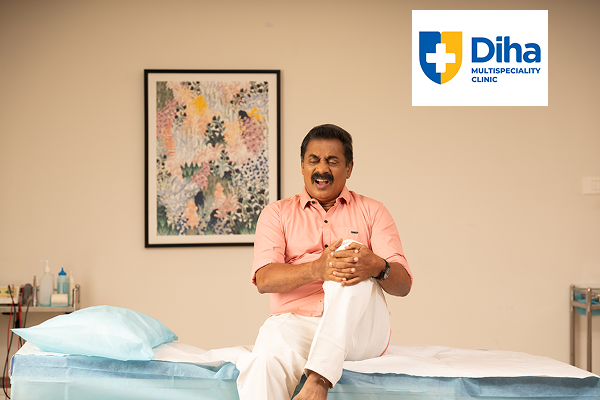- Visiting Hours: Mon-Sat / 8:00 AM - 8:00 PM
- Visiting Hours: Mon-Sat / 8:00 AM - 8:00 PM


Dr. Gopalaratnam, Senior Orthopaedist. Diha Clinic
Generally, as we age, age-related changes take place in our body. For example, our hair turns white, cataract forms in the eye, wrinkles form on the skin. In a similar way… even in the bone, changes happen. The calcium reduces… a condition called osteopenia is seen in some people. In the joints, we can see wear and tear. The knee pain comes due to degenerative changes too.
To help you understand this better, I’ll tell you a bit about the anatomy of the knee. The bottom part of the thigh bone and the top part of the leg bone join together to form the knee joint. For the joint to stay in the correct position, ligaments in the front, back and sides hold it in place. Besides that, there’s a capsule around it and within it is synovium – a layer…and a fluid is secreted called synovial fluid.
At the end of the bones is the cartilage. Over this is the synovial fluid. It supplies nourishment to the knee joints. When we age, the fluid produced reduces and degenerative changes occur. It’d look like, for example… how a fruit would be when cockroaches eat a part of it. It’s called eburnation. When it deepens, little by little the cartilage is damaged and the bone gets exposed. Due to this, the knee pain increases. As this process goes on, the pain will continue to increase. This is when degeneration is said to occur.
What are the Symptoms of Degeneration?
The knee takes the maximum weight… on the inner side. That’s why the wear and tear happens on the inside. When we take an X-Ray and check, we may see that the joint space is reduced. There’ll be pain when we press that part of the knee. Some difficulty will be felt while bending or stretching the leg… sometimes we can hear a sound. These are the symptoms of degeneration.
We can’t define at what age degeneration occurs. It depends on the work they do. Usually, it’s seen at around 55 years of age. It’s not due to infection or bacteria….it’s an age-related condition.
What Causes the Pain in the Knee to Increase?
There are a few reasons why knee pain could increase.
#1 Obesity could be a cause. When a person is a little heavy, the knee has to bear the extra weight. This leads to increase in pain.
#2 Next, standing for long hours due to the nature of work, like policemen, nurses, waiters etc. Because the joint has to bear the weight when we stand for a long time, the knee pain can aggravate.
#3 Wear and tear of the knee also leads to more pain.
#4 In the case of women, some get osteoporosis… strength of the bone reduces.
#5 If one carries a lot of weight, then too the knee which bears the weight begins to hurt.
What are the Setbacks of Degeneration?
#1 When the condition worsens, one tends to get a bow leg. Due to constant reduction of space in the inner side of the joint, the shape of the leg tends to form a curved bow shape.
#2 Another setback when degeneration occurs… is that the person finds it difficult to bend and stretch the leg.
#3 At times, the knee could swell because of the thickening of the synovial fluid. It prevents one from easily bending the knee.
#4 Movement is reduced and bow leg could be formed.
Sometimes the knee pain could increase and swelling may occur. The fluid could thicken, secretion could increase and the joint could be tense. If you touch the specific part, you may feel it’s warm.
What Should one do if Knee Pain Increases?
#1 When acute condition occurs, without effusion or pain, we can reduce the pain for a short period with medicine.
#2 We may even give a wax bath around the knee.
#3 Interferential Therapy (IFT) can be done to reduce pain.
#4 To reduce the inflammation, we may prescribe tablets.
#5 If the fluid is in excess and prevents bending of the knee, we may have to remove the fluid.
#6 After the acute pain is reduced, physiotherapy can also be done. Here’s how physiotherapy may be done…. Quadriceps drill.
Watch the video below to learn how physiotheraphy exercises can help you.
Due to this, the movement is enhanced. #6 We could also increase the production of the fluid. All this can slow down the degeneration process. Physiotherapy certainly helps slow down the process.